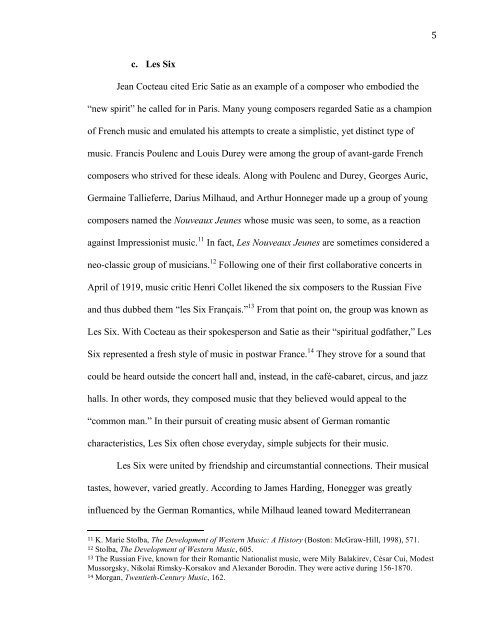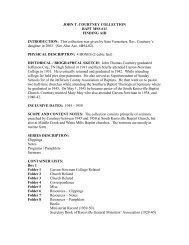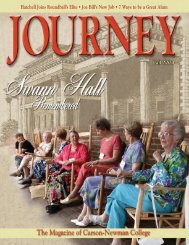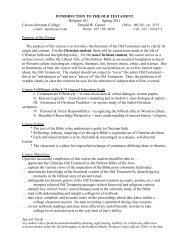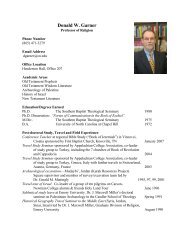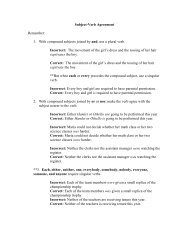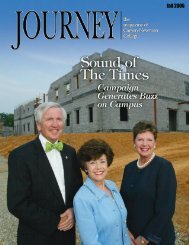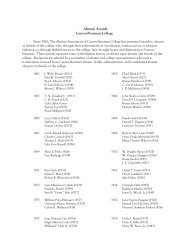a comparative analysis of louis durey and francis poulenc's settings ...
a comparative analysis of louis durey and francis poulenc's settings ...
a comparative analysis of louis durey and francis poulenc's settings ...
You also want an ePaper? Increase the reach of your titles
YUMPU automatically turns print PDFs into web optimized ePapers that Google loves.
5<br />
c. Les Six<br />
Jean Cocteau cited Eric Satie as an example <strong>of</strong> a composer who embodied the<br />
“new spirit” he called for in Paris. Many young composers regarded Satie as a champion<br />
<strong>of</strong> French music <strong>and</strong> emulated his attempts to create a simplistic, yet distinct type <strong>of</strong><br />
music. Francis Poulenc <strong>and</strong> Louis Durey were among the group <strong>of</strong> avant-garde French<br />
composers who strived for these ideals. Along with Poulenc <strong>and</strong> Durey, Georges Auric,<br />
Germaine Tallieferre, Darius Milhaud, <strong>and</strong> Arthur Honneger made up a group <strong>of</strong> young<br />
composers named the Nouveaux Jeunes whose music was seen, to some, as a reaction<br />
against Impressionist music. 11 In fact, Les Nouveaux Jeunes are sometimes considered a<br />
neo-classic group <strong>of</strong> musicians. 12 Following one <strong>of</strong> their first collaborative concerts in<br />
April <strong>of</strong> 1919, music critic Henri Collet likened the six composers to the Russian Five<br />
<strong>and</strong> thus dubbed them “les Six Français.” 13 From that point on, the group was known as<br />
Les Six. With Cocteau as their spokesperson <strong>and</strong> Satie as their “spiritual godfather,” Les<br />
Six represented a fresh style <strong>of</strong> music in postwar France. 14 They strove for a sound that<br />
could be heard outside the concert hall <strong>and</strong>, instead, in the café-cabaret, circus, <strong>and</strong> jazz<br />
halls. In other words, they composed music that they believed would appeal to the<br />
“common man.” In their pursuit <strong>of</strong> creating music absent <strong>of</strong> German romantic<br />
characteristics, Les Six <strong>of</strong>ten chose everyday, simple subjects for their music.<br />
Les Six were united by friendship <strong>and</strong> circumstantial connections. Their musical<br />
tastes, however, varied greatly. According to James Harding, Honegger was greatly<br />
influenced by the German Romantics, while Milhaud leaned toward Mediterranean<br />
<br />
11 K. Marie Stolba, The Development <strong>of</strong> Western Music: A History (Boston: McGraw-Hill, 1998), 571.<br />
12 Stolba, The Development <strong>of</strong> Western Music, 605.<br />
13 The Russian Five, known for their Romantic Nationalist music, were Mily Balakirev, César Cui, Modest<br />
Mussorgsky, Nikolai Rimsky-Korsakov <strong>and</strong> Alex<strong>and</strong>er Borodin. They were active during 156-1870.<br />
14 Morgan, Twentieth-Century Music, 162.


